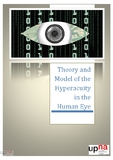Theory and model of the hyperacuity in the human eye
Fecha
2015Director
Versión
Acceso abierto / Sarbide irekia
Tipo
Tesis doctoral / Doktoretza tesia
Impacto
|
|
nodoi-noplumx
|
Resumen
The hyperacuity of the human eye may be defined as its known capacity to see small
details far away from the limitations set by the number and size of the detectors it has.
Basically, the problem consists in the fact that the image projected on the retina is
blurred by the effect of diffraction, but instead of getting an image at poor detail the
Human Visual System handles to obtain very fine ...
[++]
The hyperacuity of the human eye may be defined as its known capacity to see small
details far away from the limitations set by the number and size of the detectors it has.
Basically, the problem consists in the fact that the image projected on the retina is
blurred by the effect of diffraction, but instead of getting an image at poor detail the
Human Visual System handles to obtain very fine details. In this sense, we consider the
blurring prior to the detection stage a key for the hyperacuity in the human eye.
This way, we could assume some blurring mechanism prior to the signal detection stage,
knowing that afterwards, we may be able to restore the information just by reversing
the intentionally introduced known blur at the detection process. Under certain
conditions this blur may be compensated solving the appropriate inverse problem, and
so, a much higher resolution image can be obtained.
In addition to the explanation of the hyperacuity, we propose ideas on how this could
leverage diverse applications. As a result of applying this paradigm, the angular
resolution can be increased by even a magnitude and therefore enhancing the acuity on
applications like imaging devices, radar systems, Terahertz technology… [--]
La hiperagudeza del ojo humano puede definirse como la capacidad que tiene para
poder ver pequeños detalles lejos de las limitaciones impuestas por el número y tamaño
de los detectores que posee.
Básicamente, el problema consiste en el hecho de que la imagen proyectada en la retina
es borrosa por el efecto de difracción, pero en lugar de obtener una imagen pobre en
detalle el sistema visual ...
[++]
La hiperagudeza del ojo humano puede definirse como la capacidad que tiene para
poder ver pequeños detalles lejos de las limitaciones impuestas por el número y tamaño
de los detectores que posee.
Básicamente, el problema consiste en el hecho de que la imagen proyectada en la retina
es borrosa por el efecto de difracción, pero en lugar de obtener una imagen pobre en
detalle el sistema visual humano se las arregla para obtener detalles muy finos. En este
sentido, consideramos que el emborronado anterior a la etapa de detección es clave
para la hiperagudeza en el ojo humano.
De esta manera, podríamos suponer algún mecanismo de emborronado previo a la
etapa de detección de la señal, sabiendo que después podremos restaurar la
información simplemente invirtiendo dicho emborronado conocido el cual ha sido
introducido deliberadamente en el proceso de detección. Bajo ciertas condiciones este
emborronado puede ser compensado resolviendo el problema inverso de modo
apropiado, y conseguir así una imagen de resolución mucho mayor.
Además de la explicación de la hiperagudeza, proponemos ideas sobre cómo se podrían
aprovechar diversas aplicaciones. Como resultado de la aplicación de este paradigma, la
resolución angular puede aumentarse incluso en una magnitud y por lo tanto así la
mejora de la agudeza en aplicaciones como dispositivos de imágenes, sistemas de radar,
tecnología de terahercios... [--]
Materias
Theory and model,
Hyperacuity of the human eye,
Electrical and Electronic Engineering,
Teorías y modelos,
Hiperagudeza del ojo humano,
Ingeniería Eléctrica y Electrónica
Departamento
Universidad Pública de Navarra. Departamento de Ingeniería Eléctrica y Electrónica /
Nafarroako Unibertsitate Publikoa. Ingeniaritza Elektrikoa eta Elektronikoa Saila





